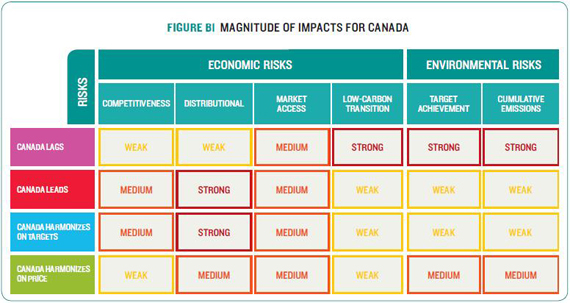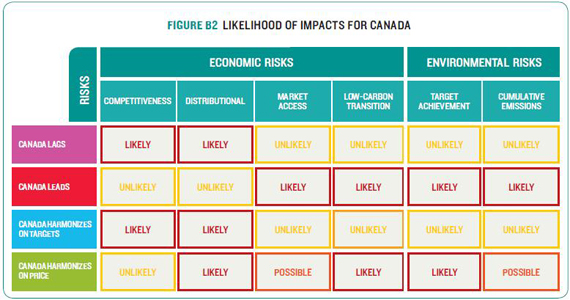Parallel Paths – 7.2 The NRTEE’s Approach to Assessing Risks
In Chapter 3 of this report, economic and environmental risks for the three main scenarios – Canada Lags, Canada Leads, Canada Harmonizes – were assessed.
To aid in our assessment, we created a Canada-U.S. Climate Policy Risk Matrix to illustrate which risks arise from each scenario. In order to present as comprehensive an illustration of risks as possible, we took a two-step approach. The matrices below illustrate this approach.
As risk is commonly defined as a combination of magnitude and likelihood of impacts, the first matrix explores the magnitude of impacts from each scenario, characterized as weak, medium, or strong. This assessment strictly focuses on the expected magnitude of the impact with no other factors considered. The second matrix then explores the likelihood of that impact occurring, characterized as unlikely, possible or likely. While there are three classifications of magnitude and likelihood in the first two matrices, the combined matrix has four. The distinction is the addition of very low risk in the third matrix which is applied to those scenarios where there is an overlap of low impact (magnitude) from the first matrix and unlikely impact (likelihood) from the second.
Because the nature of each risk is different, it cannot be compared against the others using the same metrics. For example, a competitiveness risk could be assessed partly based on GDP impacts resulting from different scenarios. The low-carbon transition, risk, however, is based on an assessment of how well a policy scenario positions Canada to compete in future low-carbon technology markets; this impact is outside both the scope and timeframe of our modelling framework. Therefore, the analysis is both quantitative and qualitative. The analysis of the risks that are more qualitative in nature is the result of extensive analysis of current climate policy issues in both Canada and the U.S. and from expert stakeholder input. Although no scenario is entirely risk-free, our quantitative and qualitative analysis allows us to characterize these risks and so identify policy choices for Canada that offer the narrowest range of risks or those that could be the most manageable.


























